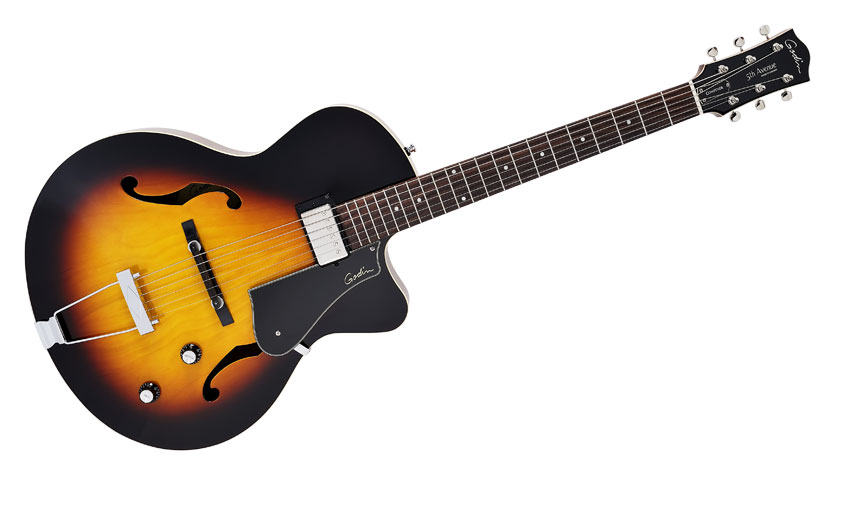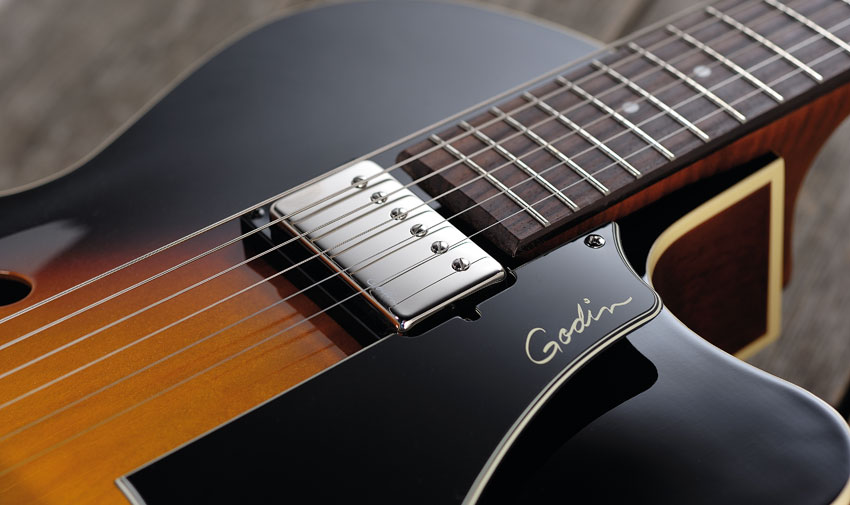MusicRadar Verdict
A 'student' version of the more costly and plusher 5th Avenue Jazz, the Composer GT looks and sounds extremely attractive if you're looking for some old-school tonality.
Pros
- +
Very tidy build. Light weight design. Classic 'jazzbox' tonality.
Cons
- -
Only those strap buttons and the side-mounted jack socket.
MusicRadar's got your back

Godin 5th Avenue Composer GT review

Neck
While Godin produces plenty of solidbody electric guitars, it's the company's Multiac and more latterly its 5th Avenue archtop ranges that have really made waves. If the former is a highly functional thin-bodied electro stage guitar - with or without synth access, and with either steel or nylon strings - the 5th Avenue is more about style.
"Fair play to Godin for spotting the interest in older archtop instruments from a wide selection of players"
Fair play to Godin for spotting the interest in older archtop instruments from a wide selection of players. Indeed, it could be suggested that Godin's high profile and huge international reach (covering some 65 countries), has renewed interest in what, for many, were dismissed as 'jazz' guitars.
As we've written on many occasions, the various acoustic and electric configurations of the 5th Avenue provide a broader brush with which to paint your sonic picture. Yes, it's a mid-depth hollowbody, so bone-crushing metal isn't its forte, but from old-style acoustic archtop styles to rootsier blues and Americana, and jazz, of course, it's a good place to start your search. We looked at the 5th Avenue Jazz sometime back, and the new-for-2013 Composer GT is a close cousin, except it's subtly down-spec'd for a way more affordable yet still classy instrument.
Build
With a gloss sunburst to the face of the guitar - the back, sides and neck are a mid-brown with a satin finish. Like the other 5th Avenue models, it's 406mm (16 inches) wide, 76mm (three inches) deep at the rim and hollow with no centre block, just two longitudinal spruce braces.
The construction quality is very clean, with the thin sides requiring acoustic-like kerfed linings as gluing area for the top and back. The cutaway is fairly flat and the neck with its archtop-like joint, sits high and is unconnected to the body under the final six frets.
The scale is subtly long, the fingerboard slightly flat and the frets are a narrow gauge by today's standards. The neck is made not from mahogany as one might expect but silver leaf maple with, on the bass side, quite a pronounced flame that not only looks classy but with its satin finish, it feels it, too.
The tuners are vintage Kluson-style and the headstock features a 'Composer' label engraved into the truss rod cover. The unpinned archtop, height-adjustable bridge is black-coloured Tusq made by Graph Tech while the strings anchor in a fairly generic-looking trapeze tailpiece. As ever, remember that the bridge isn't pinned to the top: it will move if knocked.
In typical jazz style, we just get a single neck humbucker - mounted to the top, not suspended from the neck. Removing the pickup reveals that it's made by Korean brand G&B, which supplies numerous guitar companies, not least PRS's SE range; Godin informs us it uses Alnico 5 magnets.
No selector switch is needed and we have just a single volume and tone control. There's also a chassis jack that mounts through the side - not our favourite: wood shrinks and expands, and that jack socket nut can work loose, at worst dropping off while the socket itself drops into the guitar. Be warned.
Another more Godin-specific idiosyncrasy is to fit Schaller-style locking posts as strap buttons but without supplying the locks that attach to your strap - on their own these aren't the most secure buttons, especially with a worn strap.
Sounds
It's always very difficult to second guess the sound of any semi-solid or hollowbody guitars, but it's of little surprise that the fully hollow Composer has a big acoustic sound but not a huge amount of sustain.
"Listening clean to the neck pickup, the Composer sounds like an older instrument"
Listening clean to the neck pickup, the Composer sounds like an older instrument. Smoky, less 'wide' and less pristine than most modern semi-acoustics. Of course, it's not a rock guitar and with such a large soundbox, even at quite low gig levels, you have to watch your low end, which we trimmed a little at source by reducing the bass-side height of the pickup.
At the quoted suggested selling price (SSPs) this Godin represents excellent value for money. Godins have a very workmanlike feel that reflects both their price point and intention: they feel like working guitars, not collectables.
The Composer GT is a specialised jazz-aimed guitar. But its light build, easy playability and spot-on tonality, especially plugged in, means it would be a shrewd choice for any player wanting to either nail their jazz chops or colour their songs with an extremely evocative sound.
It would be easy to mod with a piezo bridge pickup, for example, if you wanted a more contemporary sound yet, as is, in both looks and sound it sits perfectly in any 'jazz' setting - solo guitar to big- band - yet at a price that's perfect for the serious student.
Archtops and semis seem to be more popular than ever. If you're looking in those areas we strongly suggest you investigate Godin. It might not have the cool factor of other 'G' brands, but this guitar more than compensates in terms of sounds and price.
Dave Burrluck is one of the world’s most experienced guitar journalists, who started writing back in the '80s for International Musician and Recording World, co-founded The Guitar Magazine and has been the Gear Reviews Editor of Guitarist magazine for the past two decades. Along the way, Dave has been the sole author of The PRS Guitar Book and The Player's Guide to Guitar Maintenance as well as contributing to numerous other books on the electric guitar. Dave is an active gigging and recording musician and still finds time to make, repair and mod guitars, not least for Guitarist’s The Mod Squad.
“This update reflects everything we believe modern gear should be”: Neural DSP gives the Nano Cortex an almighty power-up with free NanOS 2.0.0 system update
“It’s honestly got me thinking hard about adding one to my own studio set up”: Two Notes Reload II review
“Gloriously adorned with a gold edge burst finish over a gold paisley and sparkle top”: Gretsch unveils the Paisley Penguin – a rare bird that growls – and the Honey Dipper Special, a resonator for all your roots rock manoeuvres










